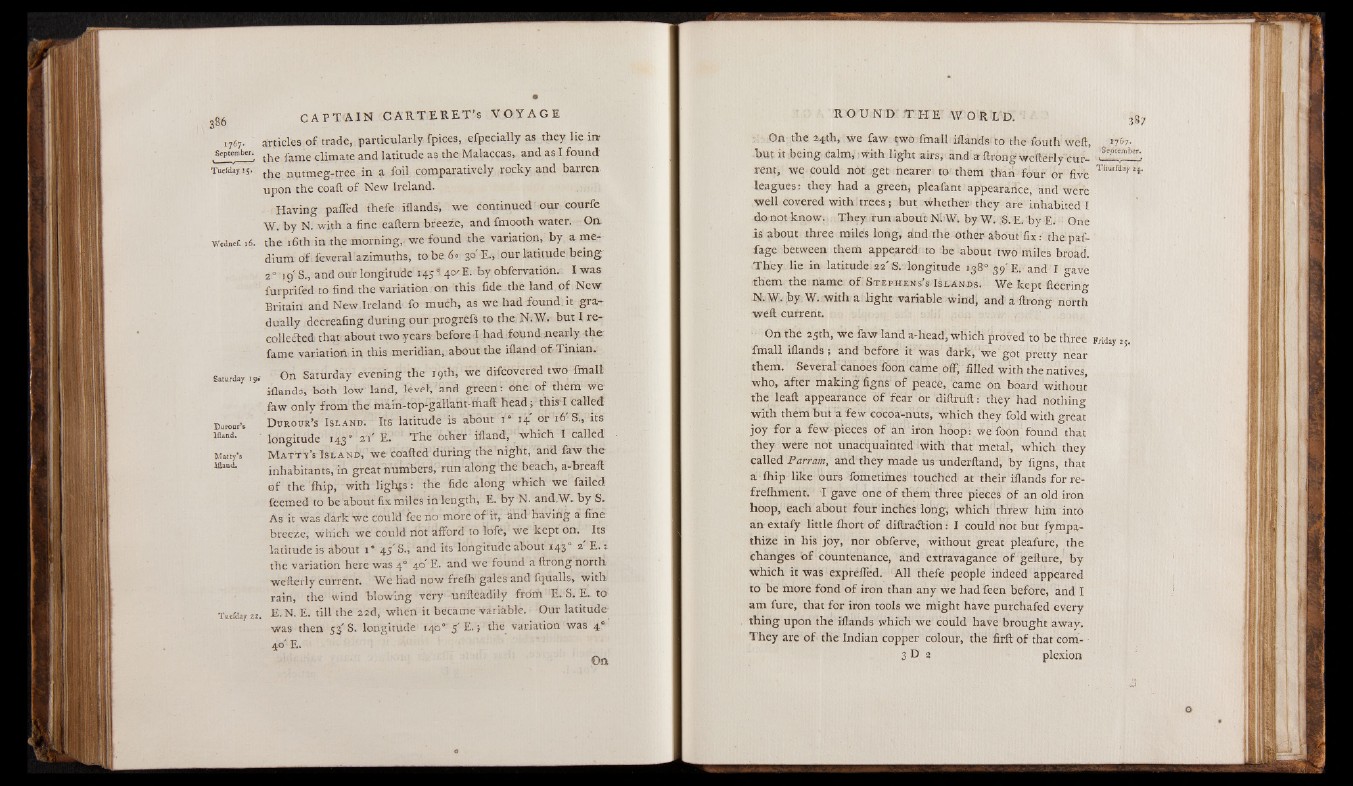
C A P T A I N C A R T E R E T ’S V O Y A G E
1767. articles of trade, particularly fpices, efpecially as they lie in;
geptemiOT. the fame climate and latitude as the Malaccas, and as I found
Tuefdayis- nutmeg-tree in a foil comparatively rocky and barren-
upon the coaft of New Ireland.
Having paffed thefe iflands; we continued our courfe
W. by N. with a fine eaftern breeze, and fmooth water. On,
Wednef. 16. the 16th in the morning,- we found the variation, by a medium
of feveral azimuths, to be 6« 30 E., our latitude being
2 ° -19' S„ and our longitude 14514 ° 'E- hV obfervatidn.- i I was
fu rp r ifed to find the variation on this fide the land of New
Britain and New Ireland fo much, as we had found it gradually
decreafing during our progrefs to the N.W. but I recollected
that about two years before I had found nearly the
fame variation in this meridian, about the iflapd o f Tinian.
Saturday .9.- On Saturday evening the 19th, we difcovered two fmall
iflands, both low'land, level, and green: one of them we
faw only from the main-top-gallant-maffi head;- this-1 called
Durour'a D u r o u r ’ s Island. Its latitude is about- i* 14 or l 6 s -> lts
Maud. longitude 143’ 21' E. The other ifland, which I called
Marty’s Matty’s Island, we coafted during the night, and faw the
Maud. inhabitants, in great numbers, run along the beach, a-breaft
of the fhip, with lig h js : the fide along which we failed
feemed to be about fix miles in length, E. by N. and.W. by S.
As it was dark we cotild fee no more o f1 it, and having a fine
breeze, which we could not afford to lofe;- we kept on. Its
latitude is about i* 45 S., and its longitude about 143° 2 E .:
the variation here was 4° 40' E. and we found a ftrong north
weflerly current. We had now frelh gales and fq-ualls, with
rain, the wind blowing very urifteadily frdrh E. S. E. to
Tuefday 22. E. N. E. till the 22d, when it became variable. Our latitude
was then 53' S. longitude 140° 5' E .} the variation was 40
40“ E.
387
1767.
September.
Thurfday 24..
R O U N D T I IE W O R LD.
On the 24th, we faw two fmall iflands to the fouth weft,
but it being calm,-with light airs; and a ftrong weflerly current,
we could not get nearer to them than four or five
leagues. they had a green, pleafant appearadce, and were
well covered with trees; but whether they are inhabited I
do not know. They tun about Ni-W. by W. E. by E. One
is about .three miles long, and the other about fix : the paf-
fage between them appeared to be about two miles broad.
They lie in latitude 22'S. longitude 138° 39' E. and I gave
them the name o f Stephens’s Islands. We kept fleering
N.W. b y W. with a light variable wind; and a ftrong north
weft current.
On the 25th, we faw land a-head, which proved to be three Friday 25.
fmall iflands, and before it was dark, we got pretty near
them. Several canoes foon came off, filled with the natives,
who, after making figns o f peace, came on board without
the leaft appearance o f fear or diftrtift: they had nothing
with them but a 'few cocoa-nuts, which they fold with great
joy for a few pieces o f an iron hoop: we foon found that
they were not unacquainted with that metal, which they
called Parram, and they made us underftand, by figns, that
a fhip like ours fometimes touched at their iflands for re-
frefhment. I gave one o f them three pieces o f an old iron
hoop, each about four inches long, which threw him into
an extafy little fhort of diftradtion: I could not but fympa-
thize in his joy, nor obferve, without great pleafure, the
changes o f countenance, and extravagance o f gefture, by
which it was exprefled. All thefe people indeed appeared
to be more fond o f iron than any we had feen before, and I
am fure, that for iron tools we might have purchafed every
thing upon the iflands which we could have brought away.
They are o f the Indian copper colour, the firft o f that com-
3 D 2 plexion
iulnl
Ir i t